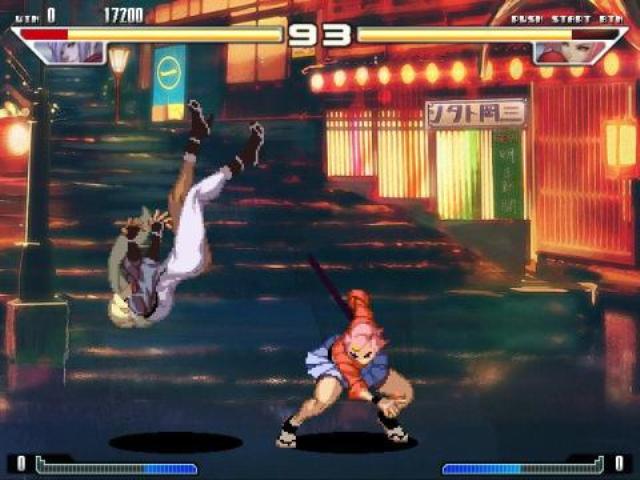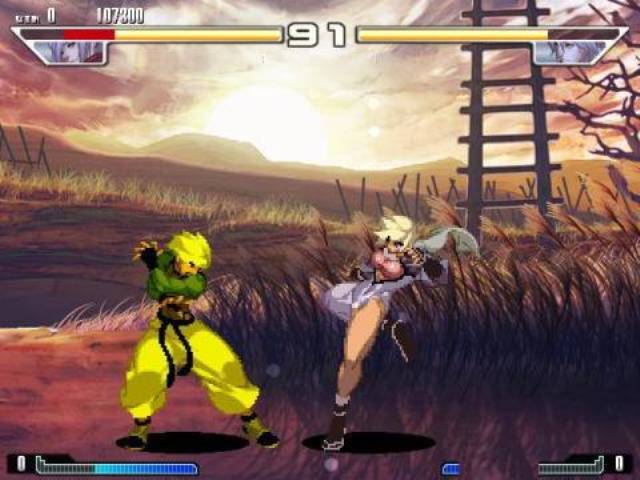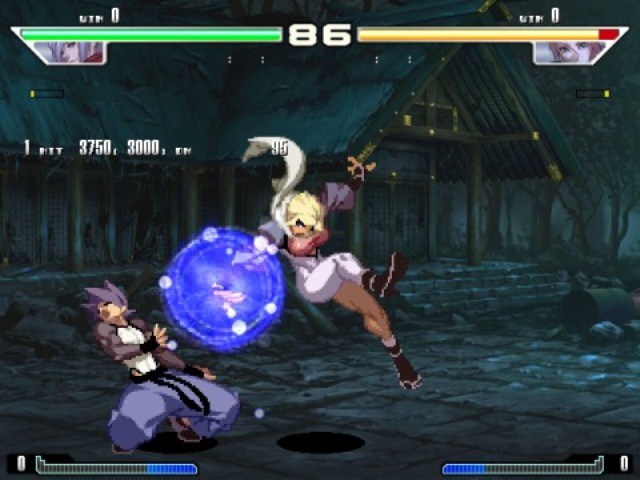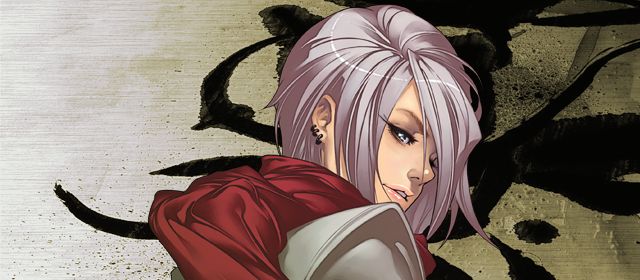As I sit here, moulding my grey matter around the Japanese indie fighter that is Yatagarasu, the song I can’t wrench from my head is the Ashford and Simpson “classic” Solid (as a Rock). Solid as a rock, that’s what this game is, that’s what we’ve got. It’s not the largest fighter in the world, or the flashiest, but it is absolutely, and beautifully, solid. As a Rock.
Yatagarasu is a fighter that adheres to a classic recipe, albeit one with an extra teaspoon of competitive spice thrown in. This mix is achieved through a careful construction that is both retro and modern – its aesthetic shamelessly evokes the 16/32-bit but its moves, techniques and concepts are cherry-picked from some of the genre’s top titles to create something competitively rich. It’s like a Victoria Sponge embellished with the best aspects of a Jamaican Ginger cake and an Apple Crumble. Classic look, rich taste.
This quality mix of genre ingredients is unsurprising given the talent behind the game. The three people behind the game, that is. Art comes courtesy of ex-SNK scribbler Kotani Tomoyuki, meaning that the game’s high quality, King of Fighters-like art should come as no surprise. Programming is by a chap calling himself Shiza, and his work on the game should be applauded – Yatagarasu feels every bit as punchy and solid as a top draw brawler should. Finally, the design of the game is that of competitive player Umezono, which explains the smart design ideas that have been included – this chap knows his stuff.

Three people made this, and yet you wouldn’t know it if no-one told you. The only hint towards this fact is that there are only eight fighters which, for a modern brawler, some might deem too few. Animation is smooth and beautiful, gameplay is silky and controls are responsive. Sure it plays in a curious 4:3 resolution but I personally see that as part of the 16/32-bit homage that so clearly defines Yatagarasu’s ethos; you’ll find quality through a re-evaluation of the genre’s past. Find those key ideas and elements and then build it up and build it up and build it up.
That’s what makes Yatagarasu so compelling. The game echoes the likes of Street Fighter 3: Third Strike and Garou: Mark of the Wolves with simple controls, a handful of skill-based concepts and short, punchy combos ruling the day. This isn’t a Marvel vs Capcom 3 or Tekken-like button recital; this is a fast, reactive battle of two brains trying to use smart mechanics to find an opening in their opponent’s defences.
The mechanics are largely lifted from other games, sure, but in the case of the parry system it’s a mechanic that Street Fighter left behind in Street Fighter IV, so it’s brilliant to see it return in Yatagarasu. In Street Fighter III the parry was found through pressing forward or down the moment an enemy attacked you. In Yatagarasu the parry features its own pair of buttons. It’s less risky to use the basic version, but there is also a better “forward and button” version for Street Fighter III aficionados. The parry is also your only form of defence in the air – a mechanic that feels largely perfect (I never was a fan of air blocking in the Street Fighter Alpha series). I would go as far as to say that the thrill of using it is hot, hot, hot.

On top of this beautiful system is dolloped a big spoonful of King of Fighters-like movement with forward hops and high jumps as well as a crushing elbow drop when you press both punch buttons. Then there are the staples: a super bar, EX special moves, delayed wake-ups, a guard meter, and an “unblockable” attack that is a variation on Street Fighter IV’s focus attack. Yatagarasu is only eight characters strong, but the tapestry weaving them together is every bit as compelling and tight as any competitive fight fan could hope for.
The characters themselves are a solid group, though not quite as varied as the likes of BlazBlue. Kou and Crow play the admittedly similar “Shoto” style, filling the Ryu and Ken slots, but the rest feel unique – even if Shimo and Hina share animation frames. All the usual types are covered, from the burly grappler to the Bruce Lee combo-fiend, but Hadouken-like attacks are in thankfully short supply – this fighter focuses more on tight and tense footsies and baits over projectile exchanges.
I keep talking about competitive play and there’s a reason for that: Yatagarasu is “old-school” in more than just its feel – its feature spread is largely retro-like as well. An arcade mode and training are the only single player diversions meaning, ultimately, that this is a fighter where most of your playtime will come from versus play, both online and off. The game even automatically saves recordings of your competitive matches and records statistics, lending further credence to its competitive side being the focus of its design.

Is this a blemish? Of course not! The fact that the game can crash on the odd occasion – I found that playing online was a nuisance in this regard – is a blemish when it occurs but it’s not fun-ruiningly frequent (perhaps down the line, they can make it better). Ultimately Yatagarasu is just such a delight to sit and play that the light feature suite doesn’t matter. The game evokes an age of tight, brash and aggressive fighters that have been almost forgotten in the mire of new combo-based releases. In terms of look and feel the game is absolutely bang on – paying respect and homage to its predecessors by the tanker-load but managing to emerge from the mixture feeling like its own beast. It really is a remarkable feat.
VERDICT: After everything is dissected, you realise that for all its features and elements and ideas it’s the quality, the solidity, of the design that really makes Yatagarasu such a joy. All of its mechanics, its animation, its hits, its flow, it all clinks, clanks and clunks with the solid whump and thump of a well-made fighter. That’s what makes it instantly appealing, and that’s what means it will continue to satisfy well into its hundredth match – it’s solid. Solid as a rock.

EXCELLENT. An 8/10 is only awarded to a game we consider truly worthy of your hard-earned cash. This game is only held back by a smattering of minor or middling issues and comes highly recommended.






